1445ss14
1445ss14.docx
Continuous Release Reporting Requirement Including Analysis for Use of Continuous Release Reporting Forms (Renewal)
OMB: 2050-0086
EPA-HQ-SFUND-2015-0100
RENEWAL OF INFORMATION COLLECTION REQUEST FOR THE CONTINUOUS RELEASE REPORTING REQUIREMENT
Including Analysis for Use of Continuous Release Reporting Forms
1. IDENTIFICATION OF THE INFORMATION COLLECTION 4
1a. Title of the Information Collection 4
1b. Short Characterization/Abstract 4
2. NEED FOR AND USE OF THE COLLECTION 7
2a. Need and Authority for the Collection 7
2b. Practical Utility and Users of the Data 8
3. NON DUPLICATION, CONSULTATIONS, AND OTHER COLLECTION CRITERIA 8
3a. Non Duplication Error! Bookmark not defined.
3b. Public Notice Required Prior to ICR Submission to OMB 9
3d. Effects of Less Frequent Collection 10
4. THE RESPONDENTS AND THE INFORMATION REQUESTED 10
4a. Respondents and SIC Codes 10
i. Data items, including record keeping requirements 10
5b. Collection Methodology and Management 17
5c. Small Entity Flexibility 17
6. ESTIMATING THE BURDEN AND COST OF THE COLLECTION 18
6a. Estimating Respondent Burden 18
Exhibit 1 – Unit Burden Hours per Respondent Information Collection Activity 20
Exhibit 1 (With Forms) – Unit Burden Hours per Respondent Information Collection Activity 21
Exhibit 2 – Burden Hours for a Typical Facility 27
Exhibit 2 (With Forms) – Burden Hours for a Typical Facility 28
6b. Estimating Respondent Costs 28
Exhibit 3 – Unit Labor Cost per Respondent Information Collection Activity 30
Exhibit 3 (With Forms) – Unit Labor Cost per Respondent Information Collection Activity 31
Exhibit 4 – Annual Labor Costs for a Typical Facility 32
Exhibit 4 (With Forms) – Annual Labor Costs for a Typical Facility 33
ii. Estimating Capital and Operations and Maintenance Costs 33
Exhibit 5 – Unit Operating and Maintenance Costs per Respondent Information Collection Activity 34
Exhibit 6 – Operating and Maintenance Costs for a Typical Facility 36
Exhibit 6 (With Forms) – Operating and Maintenance Costs for a Typical Facility 37
Exhibit 8 – Labor and Operating and Maintenance Costs for a Typical Facility 40
Exhibit 8 – (With Forms) – Labor and Operating and Maintenance Costs for a Typical Facility 41
6c. Estimating Agency Burden and Cost 41
6d. Estimating the Respondent Universe and Total Burden and Cost 46
Exhibit 10 – Number of Facilities and Hazardous Substance Releases Already Affected by the CRRR 47
6e. Bottom Line Burden Hours and Cost Tables 47
Exhibit 12 – Annual Burden Hours and Costs Incurred by Industry 49
Exhibit 12 (With Forms) – Annual Burden Hours and Costs Incurred by Industry 50
Exhibit 13 – Annual Burden Hours and Costs Incurred by Government 52
Exhibit 13 (With Forms) – Annual Burden Hours and Costs Incurred by Government 53
iii. Variations in the Annual Bottom Line 53
Exhibit 14 – Summary of Burden Hours and Costs Incurred by Industry 54
Exhibit 14 (With Forms) – Summary of Burden Hours and Costs Incurred by Industry 54
Exhibit 15 – Summary of Burden Hours and Costs Incurred by Government 55
Exhibit 15 (With Forms) – Summary of Burden Hours and Costs Incurred by Government 55
6f. Reasons for Change in Burden 55
APPENDIX A --Phone-Log Summaries…………………………………………………………..58
Continuous Release Reporting Regulations (CRRR) under the Comprehensive Environmental Response, Compensation, and Liability Act of 1980 (CERCLA) and the Emergency Planning and Community Right to Know Act of 1986 (EPCRA). OMB Control No. 2050-0086, EPA ICR No. 1445.14.
1b. Short Characterization/Abstract
This information collection request (ICR) addresses the reporting and record keeping activities required to comply with EPA’s continuous release reporting regulation (CRRR) implementing section 103(f)(2) of the Comprehensive Environmental Response, Compensation, and Liability Act of 1980 (CERCLA).
The CRRR clarifies the types of releases that qualify for reporting under CERCLA section 103(f)(2) and establishes the reporting requirements applicable to qualifying releases. Responsibility for information collection activities of the CRRR reside in the Office of Emergency Management (OEM) in the Office of Land and Emergency Management (OLEM). This ICR renews the collection activity previously approved under OMB No. 2050-0086 and applies to the period December 1, 2018 through November 30, 2021.1 Estimates of the burden placed on industry and the government to comply with the release notification requirements are presented on an annual basis.
The analysis also includes estimates for the burden and cost impacts of using continuous release reporting forms on both the industry and government in order to comply with the release notification requirements. Information pertaining to the use of continuous release reporting forms appears in “green” type.
CERCLA section 103(a) requires persons in charge of a facility or vessel to immediately notify the National Response Center (NRC) of any hazardous substance release that equals or exceeds its reportable quantity (RQ) and is not federally permitted. Notification under CERCLA is intended to ensure that Federal authorities receive prompt notification of hazardous substance releases for which a timely response may be necessary to protect public health or welfare or the environment from any adverse effects that may be associated with the release.
In addition to the reporting requirements under CERCLA section 103, section 304 of the Emergency Planning and Community Right-to-Know Act of 1986 (EPCRA) requires owner or operator of certain facilities to immediately notify the State Emergency Response Commission (SERC) and the Local Emergency Planning Committee (LEPC) for the area(s) likely affected by the release when there is a release of an extremely hazardous substance (EHS) or CERCLA hazardous substance in an amount equal to or greater than the Reportable Quantity (RQ) for that substance within a 24-hour period.
The list of CERCLA hazardous substances and EPCRA EHSs and their applicable reportable quantities are codified in 40 CFR 302.4 and Appendices A and B of 40 CFR part 355.
The information collection for immediate notification under CERCLA section 103(a) and EPCRA section 304 are in OMB Control No. 2050-0046 and 2050-0092, respectively.
Section 103(f)(2) of CERCLA provides relief from the per-occurrence notification requirements of section 103(a) for hazardous substance releases that are “continuous,” and “stable in quantity and rate,” provided that such releases are reported “annually, or at such time as there is any statistically significant increase” in the quantity of the release. Section 103(f)(2) contemplates that, in the case of certain “continuous” and “stable” releases, the notification objectives of CERCLA can be achieved with less frequent reporting. The regulated community is expected to:
• Gather necessary release data, such as the time, quantity, and source of the release;
• Notify the facility manager of the release;
• Consult with the environmental compliance expert regarding the release;
• Make an initial report of the release to the NRC;
• Submit an initial written notification to the appropriate EPA Regional Office for the geographical area where the releasing facility or vessel is located;
• Provide follow-up notification within 30 days of the first anniversary date of the initial written notification;
• Make notifications to the NRC if there is a change in the release, including a statistically significant increase in a release;
• Make an annual evaluation of releases to determine if changes have occurred in the information submitted in the initial written notification, the follow-up notification and/or in a previous change notification - if there are no changes, submittal of a report is not required.
• Keep all supporting documents, materials, and other information on file for a period of one year to substantiate the reported normal range of releases, the basis for stating that the release is continuous and stable in quantity and rate, and the other information in the initial written report, the follow-up report, and the annual evaluations.
Reporting under EPCRA section 304 is closely tied to reporting under CERCLA section 103. Under the provisions of EPCRA section 304, all releases of CERCLA hazardous substances that must be reported under CERCLA section 103(a), as well as EPCRA EHSs, must also be reported to State Emergency Response Commissions (SERCs) and Local Emergency Planning Committees (LEPCs) if the releases have a potential for off-site exposure. Releases of other EHSs, that are not CERCLA hazardous substances must be reported to SERCs and LEPCs if they occur in a manner that would require notification under CERCLA section 103(a). Similarly, releases exempt from reporting under CERCLA section 103(a), such as federally permitted releases, or releases subject to reduced reporting requirements under CERCLA section 103(f)(2), are not subject to immediate notification under EPCRA section 304.
The previous ICR inadvertently omitted collection activities and the burden and cost analysis under EPCRA, and are now being accounted for in this ICR renewal.
The continuous release reporting regulations (CRRR) is codified in 40 CFR 302.8 and 355.32 for CERCLA and EPCRA, respectively. This ICR includes reporting and recordkeeping under CERCLA and EPCRA continuous release reporting requirements.
The continuous release final rule has been in effect since September 24, 1990. This ICR utilizes historical data on the number of continuous release reports submitted to the Federal government to estimate the number of burden hours attributable to the CRRR. The statistics on the number of continuous release reports submitted to the Federal government are available through the National Response Center’s incident data base.2
In the first year of the three-year period covered by this ICR, it is estimated that 4,185 facilities will be affected by the CRRR. Of the 4,185 facilities affected in the first year, it is assumed that 7 will be reporting continuous releases for the first time and the remaining 4,178 will be meeting information collection requirements for ongoing releases. In the second and third years, it is estimated that 7 and 8 additional facilities, respectively, will generate reportable continuous releases. When calculating the burdens and costs in this ICR it has been assumed that the typical facility participates in information collection activities for each release. For example, the typical facility will provide an initial telephone notification and written report for each of its continuous releases. In fact, it is likely that many facility operators will consolidate collection activities for releases at their facilities (e.g., provide one telephone notification for several releases). Assuming eight releases per facility per year, and thus 8 information collection activities per facility per year, the total number of continuous release information collection activities in the first year of the three-year period covered by this ICR is estimated to be 33,600 (55 initial notification activities and 33,545 ongoing notification activities). In the second and third years of the period covered by this ICR, it is estimated that 59 and 63 information collection activities, respectively, will take place. The total estimated burden to respondents is approximately 333,774, 334,455, and 335,187 hours in years 1, 2, and 3, respectively. For the regulated community, the estimated information collection activity costs (including labor and O&M costs) are $19,756,584, $19,796,854, and $19,840,260 in years 1, 2, and 3, respectively. The total estimated burden to the Federal, state, and local government is approximately 41,177, 41,266, and 41,376 hours in years 1, 2, and 3, respectively. The estimated total cost to the Federal, state, and local government is $2,024,222 $2,028,598, and $2,034,010, in years 1, 2, and 3, respectively.
We estimate that the use of continuous release reporting forms will reduce overall burden to respondents by approximately 55, 59, and 63 hours in years 1, 2, and 3, respectively.3 For the regulated community, the we estimate that the information collection activity costs (including labor and O&M costs) will be reduced by $3,063, $3,293, and $3,540 in years 1, 2, and 3, respectively. The estimated burden reduction to the government is approximately 9,736, 9,757, and 9,784 hours in years 1, 2, and 3, respectively. The estimated reduction in cost to the government is $478,564, $479,577, and $480,903, in years 1, 2, and 3, respectively.
The information collection required in the CRRR (40 CFR 302.8) is authorized under CERCLA section 103(f)(2) and section 104(e). CERCLA section 103(f)(2) provides relief from the immediate notification requirements of CERCLA section 103(a) for hazardous substance releases that are “continuous,” “stable in quantity and rate,” and for which notification has been given under CERCLA section 103(a) “for a period sufficient to establish the continuity, quantity, and regularity” of the release. Further, CERCLA section 103(f)(2) requires that notification of releases qualified as continuous under the CRRR must be provided “annually, or at such time as there is any statistically significant increase” in the quantity of the release. The specific information provided in the required notifications is authorized under CERCLA section 104(e). CERCLA section 104(e) authorizes the collection of information, entry, and inspection and sampling activities for the purposes of determining the need for a response, or choosing or taking any response action under CERCLA.
As stated in section 1(b) of this document, reduced reporting provisions that apply to continuous releases under CERCLA section 103(f)(2) is also applicable to notification provided to the SERC and LEPC under EPCRA section 304 for continuous releases. In other words, releases that meet the definition of continuous releases may be reported as such under EPCRA section 304 to the SERC and LEPC, rather than making immediate notification to these entities.
In addition, CERCLA section 103(f)(2) establishes a notification system that documents information provided in the respondent notifications. The information collection and management requirements of the CRRR are necessary to determine if a response action is needed to control or mitigate any potential adverse effects associated with a reported hazardous substance release.
The information collected under the CRRR is used to evaluate the acute and chronic effects of the continuous release to determine if a response action is necessary to prevent or mitigate any adverse effects. Any hazardous substance release that equals or exceeds its RQ warrants a timely evaluation of its source, emission rate, and chemical form, the proximity of sensitive populations or ecosystems, and the ambient conditions, to ensure the protection of public health and welfare and the environment. Agency responses to continuous hazardous substance release notifications may take a number of forms ranging from requests for more detailed information (to allow for a more detailed risk assessment), to the imposition of more stringent emissions limitations, to removal and/or remedial actions. Finally, the release notification information is used by State and local government emergency planners to conduct State and local emergency response planning.
The hazardous substance release information requested under the CRRR in the initial written and follow-up reports is the minimum information necessary to properly evaluate a hazardous substance release. EPA analyzed possible areas of overlap with other regulations, concluding that there are limited areas of overlap with reporting requirements under other statutes and provisions. In particular, some facilities may need to provide similar hazardous substance release information to satisfy reporting requirements for the Toxic Release Inventory (TRI) report under EPCRA section 313. The level of duplication, however, is limited because of differences in the list of chemicals, and the NAICS/SIC and facility sizes affected by EPCRA section 313. EPCRA section 313 requirements only apply to facilities in certain NAICS/SIC categories whose inventory quantities exceed 10,000 pounds; CERCLA section 103 affects facilities in all NAICS/SIC codes regardless of inventory amounts. In addition, the EPCRA section 313 list of toxic chemicals includes only about one-fourth of the listed CERCLA hazardous substances. Further, the EPCRA section 313 list includes some substances that are not on the CERCLA list at all.
To minimize any duplication in reporting, EPA allows facilities that are subject to the reporting requirements of both regulations to submit the EPCRA section 313 report (otherwise known as the TRI report) as a substitute for the written reports required under the CRRR, provided that certain additional continuous release information is included as an addendum to the TRI report. If the TRI report is submitted in lieu of the continuous release written report, based on each source release, the following continuous release information must also be included in the TRI report: (1) the upper and lower bounds (normal range) of the release over a 24-hour period of each hazardous substance; (2) the frequency of the release from each release source; (3) a signed statement describing the basis for asserting that the release is continuous and stable in quantity and rate; (4) the population density within a one-mile radius; and (5) the identity and location of any sensitive populations and ecosystems within a one-mile radius. These additions will provide EPA with information that is not available from the TRI report, but is required to properly evaluate the need for a government response.
Additionally, continuous release reporting eliminates frequent and repetitive reporting under CERCLA section 103(a) and EPCRA Section 304 (immediate notification). If a facility with continuous releases were to report on a per-occurrence basis under CERCLA section 103(a) and EPCRA Section 304, the facility could be notifying the NRC, SERC, and LEPC daily. Respondents with continuous releases may be unnecessarily reporting under CERCLA section 103(a) and EPCRA Section 304 because they: (1) may not be familiar with the reduced reporting option under section 103(f)(2), or (2) may not realize that there is a reduced burden associated with a one-time initial telephone notification and submission of an initial written report and one follow-up report under the CRRR. EPA’s outreach efforts to increase industry awareness are described in Section 5(b). As respondents become more aware of the CRRR and the ability to simplify and reduce expenses associated with continuous release reporting, it is possible that some reports could be redirected from CERCLA section 103(a) (ERNS) to CERCLA section 103(f)(2) (CR-ERNS).
In compliance with the Paperwork Reduction Act (PRA) (44 U.S.C. 3501 et seq.), EPA has notified the public through the Federal Register notice on the renewal of this ICR (83 FR 24795, May 30, 2018). EPA received five comments which were outside the scope of this ICR.
EPA consulted with other federal and State government agencies in the development of the information collection activities described in this ICR. To develop the CRRR, EPA formed a Workgroup to address the comments received on the Notice of Proposed Rulemaking (NPRM) published on April 19, 1988 (53 FR 12868). The Workgroup consisted of representatives from various EPA program offices, the 10 EPA Regions, and the NRC. EPA Regional offices were responsible for the implementation of the final rule. Participation by these parties in the Workgroup was sufficient to address and resolve all outstanding issues. The comments received on the NPRM are addressed in the Response to Comments Document and in the preamble to the final rule.
EPA sponsored several workshops throughout the country for industry and Federal, State, and local government officials on the release notification requirements under CERCLA and SARA Title III (EPCRA), including the requirements under the CRRR. The purpose was to educate the regulated community as well as those Federal and State agencies required to implement the regulations. In addition, the workshops provided an opportunity for the public to comment on the implementation of the regulation. No workshops were conducted or planned during the period covered by ICR 1445.13. EPA revised the CRR form and instructions and we will replace the existing version on our website after OMB approval. Facilities may continue to use the form that is currently on our website at https://www.epa.gov/epcra/reporting-requirements-continuous-releases-hazardous-substances-guide-facilities-compliance.
For this renewal, seven company representatives responsible for making notifications to the NRC and submitting written follow-up reports were consulted regarding the process and burden this collection imposes. Brief summaries of those consultations are contained in Appendix A to this renewal supporting statement.
The frequency of information collection established in the CRRR is the minimum level necessary for proper evaluation of continuous releases. If the information collected under the CRRR, such as the source, frequency, and composition of the release, the environmental media affected, and the identity and location of any sensitive populations or ecosystems, were collected less frequently than stipulated under the CRRR, the Federal government’s ability to properly evaluate the threat posed by the release and the need for a response action would be jeopardized.
The regulations imposed by CERCLA section 103(f)(2) adhere fully to OMB’s general guidelines concerning the collection of information and the control of paperwork burdens on the public. The continuous release reporting regulations (CRRR) under CERCLA and EPCRA are codified in 40 CFR 302.8 and 355.32, respectively.
The regulations implementing CRRR do not require the submittal of any proprietary, trade secret, or other confidential information.
The regulations implementing CRRR do not require the submission of any sensitive business information. In addition, the information collection requested under these regulations is in compliance with the Privacy Act of 1974 and OMB Circular A-108.
This section is not applicable. The usage and release of hazardous substances are pervasive throughout industry. EPA expects a number of different industrial categories to report hazardous substance releases under the provisions of the CRRR. No one industry sector or group of sectors is disproportionately affected by the information collection burden.
To ensure that government authorities receive timely and sufficient information to evaluate potentially dangerous hazardous substance releases reported under CERCLA section 103 and EPCRA Section 304, the CRRR requires seven types of information collection activities:
An initial telephone call to the NRC, the SERC, and the LEPC;
An initial written report to the EPA Region, the SERC, and the LEPC;
A one-time follow-up written report (“first anniversary report”) to the EPA Region on or before the first-year anniversary of the submission of an initial written report. (Note: First anniversary report is not required under EPCRA section 304 continuous release reporting requirements (40 CFR 355.32).);
An annual evaluation of a release beginning the year after the submission of the one-time follow-up written report;
Notification to the NRC and EPA Region, the SERC and the LEPC, of a change in the sources, composition, or frequency of a release;
Notification to the EPA Region of a change in other information previously submitted; and
Immediate notification to the NRC, the SERC, and the LEPC of any statistically significant increase (SSI) in the quantity of a release.
Continuous Release Reporting regulations (CRRR) under CERCLA section 103 and EPCRA
section 304 are codified in 40 CFR 302.8 and 355.32, respectively. (Note: The regulations in 40 CFR 355.32 do not require facilities to submit “first anniversary report” to the SERC and the LEPC.
The time required by a facility to complete the seven information collection activities varies and is largely contingent on the nature of the reported releases and the facility’s information collection procedures. However, EPA estimated the average amount of time that is needed to perform these seven information collection activities and the average unit burden hours. The estimates are presented in section 6(a). The unit burden hours used in this ICR are based upon estimates from the CRRR economic analysis. The CRRR Economic Impact is available in rulemaking Superfund Docket Number 103(f)CR - 4-8.
Reporting continuous releases represents a reduction in burden for facilities that would otherwise report releases on a per-occurrence basis. EPA believes that the notification system developed under the CRRR represents the minimum level of reporting necessary for the Federal On-Scene Coordinator (OSC) to evaluate whether a response action is needed to prevent or mitigate any hazards to public health and welfare and the environment. The following paragraphs briefly describe the purpose and timing of each information collection activity and list the data items that comprise each notification.
Initial Telephone Notification to the NRC – The initial telephone call to the NRC, the SERC, and the LEPC serves to notify government authorities of the facility’s intent to report a hazardous substance release under CERCLA section 103(f)(2) and EPCRA Section 304. All such releases must be released in a continuous and stable manner. The initial telephone call, in conjunction with the initial written report, fulfills the statutory requirement that the release be reported under CERCLA section 103(a) and EPCRA Section 304 for a period sufficient to establish the continuity, quantity, and regularity of the release. The information provided in the initial telephone notification must include:
The name and location of the facility; and
The name(s) and identity(ies) of the hazardous substance(s) and/or EHSs being released.
Note: Substances on the CERCLA Hazardous Substances (HSs) list (40 CFR 302.4) are only reported to the NRC. However, the SERC and the LEPC are to receive notification of CERCLA HSs and EPCRA EHSs.
Initial Written Report and the Follow-up Written Report – The initial written report and the follow-up written report, which are sent to the EPA Region, the SERC and the LEPC, provide a full description of the release. (Note: The follow-up written report, “first anniversary report”, is not required to be submitted to the SERC and the LEPC.) The initial written report and follow-up written report serve as the basis for a comprehensive evaluation of the hazards posed by the release. Based on this comprehensive evaluation, government authorities determine if a response action is necessary to prevent or mitigate any adverse effects. The initial written report must be submitted within 30 days of the initial telephone call. This 30-day period does not necessarily provide enough time to collect all relevant and appropriate data, but does allow for an initial evaluation of the release. The follow-up written report (“first anniversary report”), due one year after submission of the initial written report, serves to verify the information provided on the initial written report (NOTE: there cannot be any form of change in source, composition, or frequency of release without going through the process again). The follow-up written report helps ensure that the information used to evaluate the hazards posed by the release is current and provides accurate information.
The data elements requested in the initial written and follow-up report are identical and consist of:
The name of the facility or vessel; the location, including the longitude and latitude; the case number assigned by the National Response Center or Environmental Protection Agency; the Dun and Bradstreet number of the facility (if available); the port of registration of the vessel (if applicable); and the name and telephone number of the person in charge of the facility or vessel. [40 CFR 302.8(e)(1)(i)]
A signed statement that the hazardous substance release described is continuous and stable in quantity and rate under the definitions of 40 CFR 302.8(b) and that all reported information is accurate and current to the best knowledge of the person in charge. [40 CFR 302.8(e)(1)(iv)(H)]
The population density within a one-mile radius of the facility or vessel, described in terms of the following ranges: 0-50 persons, 51-100 persons, 101-500 persons, 501-1,000 persons, and more than 1,000 persons. [40 CFR 302.8(e)(1)(ii)]
The identity and location of sensitive populations and ecosystems within a one-mile radius of the facility or vessel (e.g., elementary schools, hospitals, retirement communities, or wetlands). [40 CFR 302.8(e)(1)(iii)]
In addition, facilities must provide the following substance-specific information for each continuous release:
The sources of the release, including specific source information (e.g., valves, pump seals, storage tank vents, stacks). [40 CFR 302.8(e)(1)(iv)(C)]
The environmental medium (a) affected by the release: if air, provide stack height or surface area affected; if surface water, the name of the surface water body; if a stream, the stream order or average flow rate and designated use; if a lake, the surface area and average depth; if on or underground, the location of public water supply wells within two miles. [40 CFR 302.8(e)(1)(iv)(G)(1-4)]
The frequency of the release and the fraction of the release from each release source and the period over which it occurs. [40 CFR 302.8(e)(1)(iv)(D)]
A brief statement describing the basis for stating that the release is continuous and stable in quantity and rate. [40 CFR 302.8(e)(1)(iv)(E)]
The name and identity of the hazardous substance; and the Chemical Abstracts Service Registry Number for the substance. If the release is a mixture, the hazardous substance components of the mixture and their approximate concentrations and quantities, by weight. [40 CFR 302.8(e)(1)(iv)(A)]
The upper and lower bounds of the normal range of the release over the previous year. [40 CFR 302.8(e)(1)(iv)(B)]
An estimate of the total annual amount of the hazardous substance released in the previous year (in pounds or kilograms). [40 CFR 302.8(e)(1)(iv)(F)]
The regulations in 40 CFR 355.32 provides requirements for continuous release reporting under EPCRA section 304, which cross-reference the regulations in 40 CFR 302.8.
(a) Initial notifications as specified in 40 CFR 302.8 (d) and (e).
(b) Notification of a “statistically significant increase,” defined in 40 CFR 302.8(b) as any increase above the upper bound of the reported normal range.
(c) Notification of a “new release” as specified in 40 CFR 302.8(g)(1).
(d) Notification of a change in the normal range of the release as specified under 40 CFR 302.8(g)(2).
Annual Evaluation of a Release – Although a reporting facility is no longer required to submit a written report on its continuous releases after submitting a one-time written follow-up report to the EPA Region verifying the information provided on the initial written report remained the same, the reporting facility must conduct and document an annual assessment of its continuous releases beginning the year after the submission of the follow-up written report (“first anniversary report”). The purpose of the annual evaluation is to identify any changes that may have occurred in the release situation over the preceding year. The annual evaluation of a continuous release helps ensure that the information used to evaluate the hazards posed by the release is current and accurate information.
Change in the Source, Composition, or Frequency of a Release Report – If there is a change in the source, composition, or frequency of a release, the release must be reported and treated as a new continuous release. An initial telephone notification and written report must be provided as described above. The person in charge also must submit a follow-up report within one year of the change report.
Other Changes in Information – Facilities experiencing a change in a continuous release that invalidates information previously submitted on the continuous release must notify the appropriate EPA Region, by letter within 30 days of the change. The letter regarding the change in the release should explicitly identify the new (or changed) information and include an explanation for the change. For example, a facility must notify EPA if any schools, hospitals, retirement homes, or other developments housing sensitive populations are open within one mile of the facility.
Statistically Significant Increase Report – The CRRR defines a SSI as a release of a hazardous substance that exceeds the upper bound of the normal range of the release as established by the facility. The normal range of a release is defined by the range of release weights (in pounds or kilograms) recorded during the preceding year under normal operating conditions (that is, conditions that prevail during the period establishing the predictability and regularity of the release). Therefore, a SSI does not include releases within the reported normal range of release. An SSI release is considered an episodic release because it is a release above the RQ. Thus, SSIs must be immediately reported to the NRC, the SERC, and the LEPC, by telephone pursuant to the notification requirements of CERCLA section 103(a) and EPCRA Section 304. The information reported to the NRC in a SSI report includes the same information supplied when reporting any other episodic release (e.g., quantity of the release, source of the release, and a description of any response actions taken). Information provided to the SERC and the LEPC for any type of release (including SSI described here) is codified in 40 CFR 355.40.
The person in charge of a facility with a SSI may modify the previously established normal range as an alternative to reporting multiple SSIs. To modify the normal range of the release over a 24-hour period under normal operating procedures, the person in charge of the facility must report at least one SSI to the NRC, the SERC, and the LEPC as an episodic release (to facilitate immediate evaluation), and then must submit a written change report of the release information to the appropriate EPA Region, the SERC, and the LEPC describing the new normal range and reasons for the change; thus, treating the SSI as a new release. Thus, for example, if a facility doubles its production level thereby doubling its release level, the facility may want to double its reported normal range of the continuous release, rather than reporting multiple SSIs. The person in charge also must submit a follow-up report “first anniversary report” within one year of the submission of the change report. Note: The “first anniversary report” is not required as per continuous release reporting regulations under EPCRA section 304.
Record keeping – Facilities may maintain a log or some other record of each hazardous substance release reported as continuous under CERCLA section 103(f)(2). The information documented in the record can be used to demonstrate compliance with the provisions of the CRRR, including the requirement to demonstrate the continuity and stability of the release and the requirement to conduct an annual evaluation of the release. Additionally, facilities may find it useful to document daily release quantities for use in substantiating and modifying the normal range of the release.
To comply with the provisions of the CRRR, the regulated community performs the following information collection activities:
Provides an initial telephone call to the NRC, the SERC, and the LEPC;
Provides an initial written report to the EPA Region, the SERC, and the LEPC;
Prepares a one-time follow-up written report (“first anniversary report”) for the EPA Region on or before the first-year anniversary of the submission of an initial written report;
Conducts an annual evaluation of a release beginning the year after the submission of the one-time follow-up written report;
Prepares change in the sources, composition, or frequency of a release reports to the EPA Region, the SERC, and the LEPC;
Prepares change in other information reports to the EPA Region;
Provides immediate notifications of SSIs to the NRC, the SERC, and the LEPC; and
Maintains a log or other formal record to document compliance with the CRRR.
Each of these notification and record keeping activities is listed and described in detail in section 4(b)(i), above. In addition to these activities, persons in charge of a facility may be required to perform supplemental collection activities in response to the Federal government’s evaluation of the facility’s continuous release reports. In situations where EPA’s evaluation of release reports engenders concern over potential adverse effects, EPA may require the person in charge of the facility in question to submit the additional information or clarify and refine information previously submitted. EPA may use this additional information to better assess the risks associated with the release. Finally, in response to a release report or additional information, EPA may conduct a site inspection. Industry personnel accompany EPA personnel during the site inspection to address any questions, concerns, or information requests that may arise. Thus, the following other activities are included within the information collection activities performed by the regulated community:
Provision of additional information; and
Site inspection.
Estimates of the burden hours incurred by industry as a result of reporting continuous releases were developed based on estimates of the time expended in providing a specific report (e.g., the initial telephone call, the initial written report, the follow-up written report) as opposed to developing estimates for each work element (e.g., gathering information, reviewing report formats, completing reports) involved in completing all of the required activities. The burden estimates for each information collection and record keeping activity performed by the regulated community under the CRRR are presented in Section 6(a) of this ICR.
Each of the notification reports submitted by industry is processed and evaluated by Federal authorities, the SERC, and LEPC personnel. For some continuous releases evaluated under the CRRR, EPA may request additional (supplemental) information or clarification of information previously submitted by a facility. EPA may use this information to conduct a more in-depth risk assessment of the release. In some extreme cases, the in-depth risk assessment may not allay EPA’s concerns and EPA may decide to conduct a site inspection to review the circumstances associated with the release first-hand. Additionally, site inspections may be conducted periodically as a compliance and enforcement measure. Thus, the Agency performs the following other activities as a result of continuous releases reported under CERCLA section 103(f)(2):
• Request additional information; and
• Conduct site inspections.
Estimates of the burden hours incurred by the Federal government (NRC and EPA Region), the SERC and the LEPC personnel are developed based on estimates of the time expended in processing the notification reports required under the CRRR (e.g., the initial written report, SSI notification) or completing another activity (e.g., additional information, site inspection) as opposed to developing estimates for each work element (e.g., reviewing data, entering data, filing, evaluating a release, storing evaluation results) involved in completing all of the required activities. The burden estimates developed for each of the processing, evaluating, and other activities performed by the Federal government are presented in Section 6(c) of this ICR.
To facilitate collection and storage of information on continuous releases, EPA developed CR-ERNS. CR-ERNS is an information management system that serves as the depository for continuous release information received by the EPA Regions. CR-ERNS is designed to assist EPA Regional personnel in managing continuous release information and establishing priorities with respect to the review and evaluation of continuous release reports. The reports submitted to the EPA Regions include the initial written report, the follow-up report, and changes in release reports. Additionally, the NRC immediately notifies the appropriate EPA Region of any SSI reports.
The notification requirements under section 103(a) of CERCLA and section 304 of EPCRA and the reporting relief available under section 103(f)(2) apply equally to all firms regardless of size. There are no special information collection or record keeping requirements on small businesses. EPA believes that the notification system developed under the CRRR represents the minimum level of reporting necessary for the Federal OSC to evaluate whether a response action is needed to prevent or mitigate any hazards to public health and welfare and the environment. A reduction in the reporting requirements facing small businesses is not possible without jeopardizing the quality of the information needed to evaluate the threat posed by the release and the need for a Federal response.
The facility must provide an initial telephone call to the NRC, the SERC, and the LEPC as soon as the person in charge has knowledge of a hazardous substance release that equals or exceeds its RQ. The caller must decide whether to report the release under CERCLA section 103(a) and EPCRA section 304 (i.e., as an episodic release) or CERCLA section 103(f)(2) (i.e., as a continuous release). The reporting and record keeping activities associated with reporting an episodic release under CERCLA section 103(a) and EPCRA section 304 are presented in OMB Control numbers 2050-0046 and 2050-0092, respectively. If the caller reports a continuous release, the initial written report required by CERCLA section 103(f)(2) (codified in 40 CFR 302.8 and 355.32) must be provided within 30 days of the initial telephone call. In the second year of reporting, the facility must submit a written follow-up report to the EPA Region within 30 days of the anniversary date of submission of the initial written report. This report is sometimes called the First Anniversary Report. (Note: Facilities are not required to submit the “first anniversary report” to the SERC and the LEPC). Thereafter, the reporting facility is responsible for reevaluating the release annually, but no reports are required unless there is a change in the sources or composition of a release, a change in release information previously submitted, or an SSI in the release.
SSIs in a release are considered to be episodic releases and must be reported as soon as the person in charge is aware that an SSI has occurred. If there is a change in the information submitted in the initial written or follow-up report, other than a change in sources, composition, or frequency of the release, the person in charge must submit a letter detailing the change to the EPA Region within 30 days of determining that a change has occurred. See section 4(b) of this ICR for details on various reports and notifications required by facilities under continuous release reporting regulations.
To report a continuous release, the regulated community performs the following activities (outlined in Section 4(b) of this ICR): (1) provides an initial telephone notification to the NRC, the SERC, and the LEPC; (2) prepares an initial written report for the EPA Region, the SERC, and the LEPC; (3) prepares follow-up written report (“first anniversary report”) for the EPA Region on the first-year anniversary of the submission of the initial written report; (4) conducts an annual evaluation of the release beginning the year after the submission of the one-time follow-up written report; (5) reports a change in the sources, composition, or frequency of the release; (6) reports a change in other information; (7) reports SSIs in the release; (8) complies with other activities; and (9) keeps records on the release, including documentation of the annual evaluation. Activities (5), (6), (7), and (8) are conditional activities and are necessary for only a small fraction of all the continuous releases reported each year. For example, SSIs are defined in the CRRR as hazardous substance releases whose quantity exceeds the upper bound of the normal range, where the normal range includes all releases of the hazardous substance reported or occurring during the previous year. Thus, only a small fraction of facilities experience SSIs in their continuous releases in a given year.
When calculating the burden and costs in this ICR it is assumed that the typical facility participates in all the necessary information collection activities for each release. For example, the typical facility will provide an initial telephone notification and written report for each of its continuous releases. In fact, it is likely that many facility operators will consolidate collection activities for releases at their facility (e.g., provide one telephone notification for several releases).
The estimated burden hours for each of the activities listed in the paragraph above are presented in Exhibit 1. The burden estimates are taken from the CRRR economic impact analysis and are based on CERCLA reporting experience, SARA (EPCRA) section 313 reporting experience, and professional judgment. A description of the basis for each burden estimate, as well as the percentage of continuous releases for which the burden is expected to be incurred, is provided in the remainder of this section.
Exhibit 1 – Unit Burden Hours per Respondent Information Collection Activity
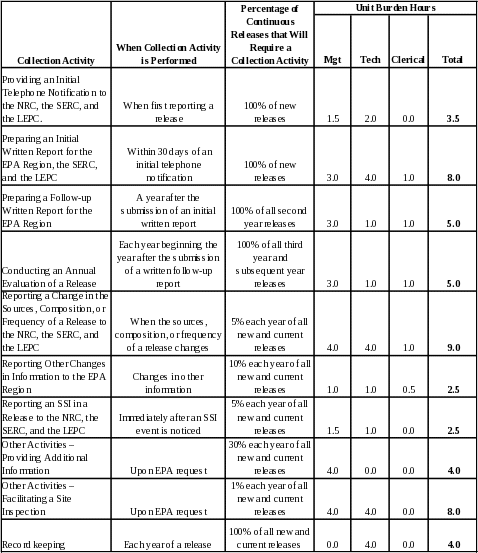
The estimated burden hours for each of the activities listed in the paragraph above are presented in Exhibit 1 (With Forms). The burden estimates are taken from the CRRR economic impact analysis and are based on CERCLA reporting experience, SARA section 313 reporting experience, and professional judgment. A description of the basis for each burden estimate (including where there might be some savings due to the use of the continuous release reporting forms), as well as the percentage of continuous releases for which the burden is expected to be incurred, is provided in the remainder of this section.
Exhibit
1 (With Forms) – Unit Burden Hours per Respondent Information
Collection Activity
Providing an Initial Telephone Notification to the NRC, the SERC and the LEPC – In providing the initial telephone notification, facilities incur a one-time, first-year burden of notifying the NRC, the SERC, and the LEPC that a hazardous substance release is reported under continuous release (CERCLA section 103(f)(2)). Providing the required information by telephone to the NRC, the SERC, and the LEPC is estimated to require 15 minutes each (0.25 hours or 0.75 hours total) of management time. Prior to the telephone call, however, the facility must determine if the release is continuous and stable in quantity and rate as defined in the CRRR. This determination is estimated to require 45 minutes (0.75 hours) of management time and 2.0 hours of technical time. A total of 1.50 hours of management time and 2.0 hours of technical time should be sufficient to determine if a release is continuous because facilities likely to be affected by the CRRR should be familiar with the reporting requirements of CERCLA section 103 and EPCRA Section 304. In total, the burden associated with the initial telephone call is three and a half hours.
We do not expect that use of the continuous release reporting forms will reduce the total burden associated with the initial telephone notification to the NRC, the SERC, and the LEPC.
Preparing an Initial Written Report – The burden associated with providing the initial written report is also a one-time, first-year cost. Much of the information required for the initial written report (e.g., facility identification, hazardous substance identification, frequency and source of the release) is readily available to the facility. Information such as the composition of the release and the environmental media affected, however, may require more extensive consideration and analysis. In addition, some time is needed to organize and format the required information into a report suitable for submission to the government. It is assumed that many facilities will use EPA’s prepared report format to minimize report organization and formatting efforts. Preparation of the initial written report that uses EPA’s prepared report format is estimated to require 3.0 hours of managerial time, 3.0 hours of technical time, and 1.0 hour of clerical time. To account for the burden experienced by the facilities that do not use EPA’s prepared report format, EPA has increased the technical burden to 4.0 hours. The costs of photocopying and mailing this report and all other reports to the appropriate EPA Region, the SERC, and the LEPC are computed in Section 6(b). Preparation of the initial written report is estimated to require 3.0 hours of managerial time (including 1.0 hour of legal review), 4.0 hours of technical time, and 1.0 hour of clerical time. Thus, the total burden associated with the initial written report is 8.0 hours.
Estimated savings for use of continuous release reporting forms is found in the reduction of technical time from 4.0 hours to 3.0 hours, thus the total burden associated with the initial written report is 7.0 hours.
Preparing a Follow-up Written Report (“First Anniversary Report”) – Within one year of submitting the initial written report, facilities must submit a one-time follow-up written report to the appropriate EPA Region. (Note: Facilities are not required to submit “first anniversary report” to the SERC, and the LEPC). The follow-up report requires the same information as the initial written report but serves to confirm, update, and refine the information provided in the initial report based on release data from the previous operating year. Because some of the technical information gathered for preparation of the initial written report, such as the source of the release and specific information describing the environmental media affected remains unchanged, preparation of the follow-up report requires less technical time than preparation of the initial written report. EPA estimates that preparation of the follow-up report requires 3.0 hours of managerial time, 1.0 hour of technical time, and 1.0 hour of clerical time. In total, the burden associated with the follow-up written report is 5.0 hours. The burden associated with the follow-up written report is incurred in the second year of reporting.
We do not expect that use of the continuous release reporting forms will reduce the total burden associated with the follow-up written report.
Conducting an Annual Evaluation of the Release – Although the written follow-up report is prepared and submitted only once, facilities are required to conduct and document an annual evaluation of each hazardous substance release reported under CERCLA section 103(f)(2) beginning the year after submitting the follow-up written report. This annual evaluation is comparable to the review and information collection necessary for preparation of the follow-up report. The burden associated with the annual evaluation, therefore, is assumed to be the same as the burden of preparing the written follow-up report (5.0 hours). The burden associated with the annual evaluation is incurred in the third and all subsequent years.
We do not expect that use of the continuous release reporting forms will reduce the total burden associated with the annual evaluation of the release.
Reporting a Change in the Sources, Composition, or Frequency of the Release – When a facility experiences a change in the sources, composition, or frequency of a release, the release is considered a new release because the associated hazard may have changed significantly. Changes in the sources, composition, or frequency of a release are expected to result only from significant changes in the production process, such as the installation of new equipment or a change in the chemical nature of the process. While such significant changes are expected over the long-term, the likelihood of such a change occurring in a particular year is small. EPA estimates that the number of already reported continuous releases that experience a change in sources, composition, or frequency is equal to 5 percent of the total number of hazardous substance releases being reported under the CRRR in any given year.
Facilities experiencing a change in the sources, composition, or frequency of a continuous release must complete the initial notification process for the release (i.e., an initial telephone call to the NRC, the SERC, and the LEPC and an initial written report to the EPA Region, the SERC, and the LEPC and follow-up report to the EPA Region. For facilities experiencing a change in the sources, composition, or frequency of a continuous release, much of the information from the previous initial written report (e.g., facility identifiers, the media affected) should not have changed. It is assumed that the technical time required evaluating the release, determining whether it is stable in quantity and rate, and accurately document the composition of the release and the environmental media affected would take 4.0 hours. The number of management and clerical hours required to report a new continuous release are assumed to be 4.0 hours and 1.0 hour respectively. Thus, the total burden associated with reporting a change in the sources, composition, or frequency of a continuous release is 9.0 hours.
We do not expect that use of the continuous release reporting forms will reduce the total burden associated with reporting a change in the sources, composition, or frequency of a total continuous release.
Reporting Other Changes in Information – For changes other than a change in the sources, composition, or frequency of a release, the person in charge must notify the EPA Region by letter that the information previously submitted in support of a continuous release notification is no longer valid. For example, the population density in the vicinity of the facility would be reported by submitting a letter detailing the change and its cause. Such changes in information previously submitted are likely to occur over an extended period of time, but are much less likely to occur every year. EPA estimates that, on an annual basis, approximately 10 percent of the releases reported under CRRR will experience a change that requires submission of a letter to the EPA Region. Gathering and reporting the change in the release by a letter to the EPA Region is estimated to require 1.0 hour of managerial time, 1.0 hour of technical time, and 0.5 hours of clerical time for a total burden of 2.5 hours.
We do not expect that use of the continuous release reporting forms will reduce the total burden associated with reporting other changes in information.
Reporting a Statistically Significant Increase in the Release – As soon as the person in charge of a facility has knowledge that the quantity of a continuous release being reported under continuous release (CERCLA section 103(f)(2)) exceeds the upper bound of its previously established normal range of release weights, the person in charge must notify the NRC, the SERC, and the LEPC. SSIs are episodic release events because the release has not been previously reported or evaluated. To avoid underestimating the burden, this ICR includes the burden for reporting an SSI, even though the burden may be captured in the ICR for episodic releases (OMB Control No. 2050-0046 and 2050-0092). The estimated burden of reporting an SSI is based on interviews with chemical industry personnel and the burden associated with reporting similar episodic releases under CERCLA section 103(a) and EPCRA section 304. EPA estimates that reporting of an SSI requires 1.5 hours of managerial time and 1.0 hour of technical time for a total burden of 2.5 hours. The technical time consists of determining if the release is reportable, briefing management, and collecting the information required for NRC, the SERC, and the LEPC reporting. The managerial time includes alerting appropriate personnel and transmitting the information required in the telephone calls.
Because SSIs are defined as releases that exceed the normal range, and the normal range is defined to include all release quantities recorded during the previous operating year, EPA estimates that no more than 5 percent of the hazardous substance releases reported under the CRRR will experience an SSI in a given year.
We do not expect that use of the continuous release reporting forms will reduce the total burden associated with reporting a statistically significant increase in the release.
Other Activities – In response to the government’s processing and evaluating the initial and follow-up reports, persons in charge of facilities may be required to: (1) provide additional information or clarify information previously submitted; and (2) accompany EPA personnel during a site inspection.
(1) Providing Additional Information – For some percentage of the continuous releases reported under the CRRR, the information provided in the initial and/or follow-up reports will be incomplete, incorrect, or worrisome, prompting EPA to request additional information regarding the nature and extent of the release. For example, EPA may seek additional information concerning release activity in order to better assess the risk posed by the release. EPA estimates that approximately 30 percent of the initial/follow-up reports could require submission of additional information or some level of interaction with EPA in the first and second years of reporting. Beginning in the third year of reporting, requests for additional information and further clarification of release information are assumed to be necessary only for newly reported releases. However, this analysis conservatively assumes that the percentage of reportable releases for which additional information is necessary will remain at 30 percent for all years of reporting. For each hazardous substance report that requires additional communication with EPA, industry is estimated to expend 4.0 hours of managerial time.
We do not expect that use of the continuous release reporting forms will reduce the total burden associated with reporting other activities.
(2) Facilitating a Site Inspection – In extreme cases, the preliminary risk assessment of a release will indicate the need for a site inspection, allowing EPA to directly assess and evaluate the circumstances of a release and the population and environment potentially affected by the release. In addition, site inspections are conducted periodically as a compliance and enforcement measure. Site inspections are estimated to be necessary for no more than one percent of the reported continuous releases. EPA estimates that facility participation in a site inspection requires four hours of managerial time and four hours of technical time for a total burden of 8.0 hours.
We do not expect that use of the continuous release reporting forms will reduce the total burden associated with facilitating a site inspection.
Record keeping – EPA assumes many facilities maintain a log or some other record of each hazardous substance release reported under the CRRR. Facilities may find it useful to collect and record the following information for use in demonstrating compliance with the provisions of CERCLA section 103(f)(2): (1) estimates of daily release quantities to demonstrate the continuity and stability of the release, and to establish and modify the normal range of the release; (2) documentation of the methodology and calculations used in estimating required information; and (3) documentation of the annual assessment required each year subsequent to submission of the follow-up written report. Much of the time necessary to gather these records has already been attributed to the preparation of the initial and follow-up reports, however, it is estimated that an additional 4.0 hours of technical time is necessary for keeping records on each hazardous substance release reported under the CRRR.
We do not expect that use of the continuous release reporting forms will reduce the total burden associated with record keeping.
The estimated annual burden hours incurred by a “typical” facility are presented in Exhibit 2. A typical respondent is assumed to report eight continuous hazardous substance releases in year one and to experience a change in one release in the second and third years of reporting (e.g., the frequency of the release increases from three to five times a week, causing a modification in the estimated annual release amount). No other conditional activities (e.g., SSI reporting and facilitating a site inspection) are assumed to be required of the typical respondent; the inclusion of burden estimates associated with any additional conditional activities may result in a significant overestimation of the burden incurred by a typical facility.
Exhibit 2 – Burden Hours for a Typical Facility
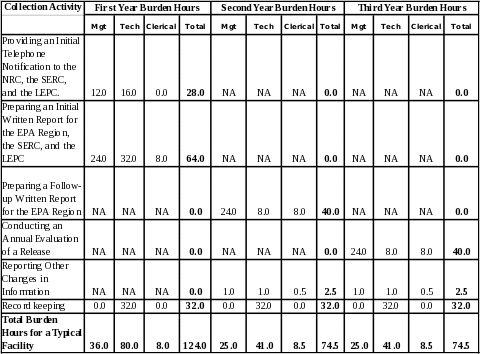
A “typical” respondent is assumed to report eight continuous hazardous substance releases in year one and to experience a change in one release in the second and third years (e.g., the frequency of the release per week changes each year, causing a modification in the estimated annual release amount). No other conditional activities are assumed to be required of the typical respondent.
|
NA = Not Applicable
The estimated annual burden hours incurred by a “typical” facility are presented in Exhibit 2 (With Forms). A typical respondent is assumed to report eight continuous hazardous substance releases in year one and to experience a change in one release in the second and third years of reporting (e.g., the frequency of the release increases from three to five times a week, causing a modification in the estimated annual release amount). No other conditional activities (e.g., SSI reporting and facilitating a site inspection) are assumed to be required of the typical respondent; the inclusion of burden estimates associated with any additional conditional activities may result in a significant overestimation of the burden incurred by a typical facility.
Exhibit 2 (With Forms) – Burden Hours for a Typical Facility
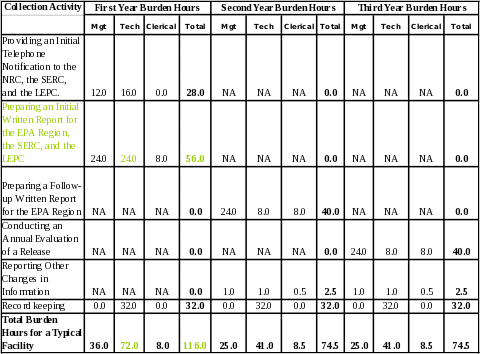
|
A “typical” respondent is assumed to report eight continuous hazardous substance releases in year one and to experience a change in one release in the second and third years (e.g., the frequency of the release per week changes each year, causing a modification in the estimated annual release amount). No other conditional activities are assumed to be required of the typical respondent. |
N/A – Not Applicable
The estimated cost to complete various continuous release reports required under the CRRR is a function of the time expended by industry personnel (i.e., the burden estimates presented in section 6(a)), and the hourly wage rates for the appropriate categories of labor. The hourly wage rates used for industry in this ICR are from March 2018 and were obtained from the Bureau of Labor Statistics.4 For purposes of this analysis, EPA estimates an average hourly respondent labor cost of $68.92 for managerial staff, $55.87 for technical staff, and $26.68 for clerical staff.
These rates reflect the employer costs for employee compensation in the United States as of March 2018 and include both employer costs for legally required benefits (e.g., social security, worker’s compensation, and unemployment insurance), other important fringe benefit categories (e.g., insurance, paid leave, retirement, and savings), and overhead and general and administrative costs. Costs associated with the burden hours presented in Section 6(a) of this ICR are shown in Exhibit 3.
Exhibit 3 presents the unit costs to industry of performing the notification, record keeping, and other activities that may be required in reporting a continuous release. The unit cost of each collection activity is calculated by multiplying the annual burden hour estimates in Exhibit 2 by the hourly wage rate for the appropriate labor category (listed above).
Exhibit 3 – Unit Labor Cost per Respondent Information Collection Activity
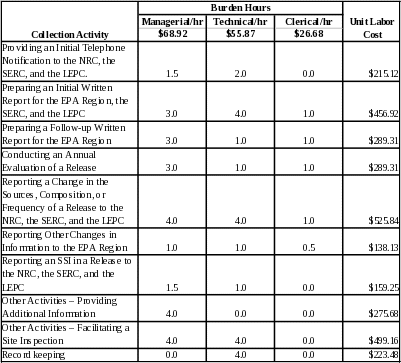
Exhibit 3 (With Forms) presents the unit costs to industry of performing the notification, record keeping, and other activities that may be required in reporting a continuous release. The unit cost of each collection activity is calculated by multiplying the annual burden hour estimates in Exhibit 2 (With Forms) by the hourly wage rate for the appropriate labor category (listed above).
Exhibit 3 (With Forms) – Unit Labor Cost per Respondent Information Collection Activity
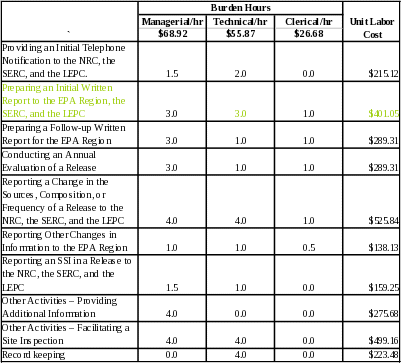
Exhibit 4 presents the annual labor cost estimated to be incurred by a typical facility. (The reporting pattern assumed for a typical facility is discussed in Section 6(a) above.)
Exhibit 4 – Annual Labor Costs for a Typical Facility
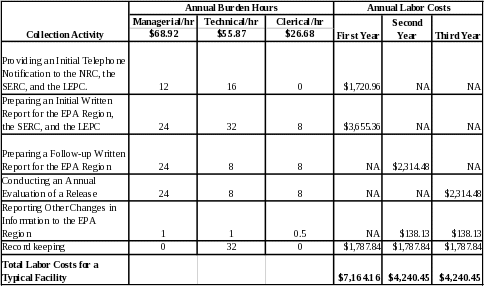
A “typical” respondent is assumed to report eight continuous hazardous substance releases in year one and to experience a change in one release in the second and third years (e.g., the frequency of the release per week changes each year, causing a modification in the estimated annual release amount). No other conditional activities are assumed to be required of the typical respondent. |
N/A = Not Applicable
Exhibit 4 (With Forms) presents the annual labor cost estimated to be incurred by a typical facility using the continuous release reporting forms (The reporting pattern assumed for a typical facility is discussed in Section 6(a) above.)
Exhibit 4 (With Forms) – Annual Labor Costs for a Typical Facility
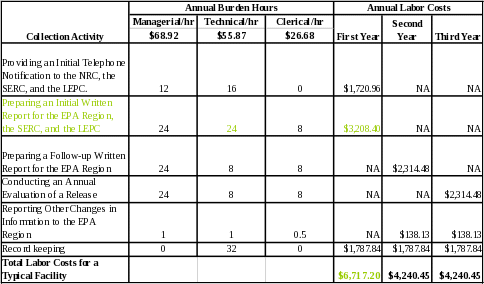
A “typical” respondent is assumed to report eight continuous hazardous substance releases in year one and to experience a change in one release in the second and third years (e.g., the frequency of the release per week changes each year, causing a modification in the estimated annual release amount). No other conditional activities are assumed to be required of the typical respondent. |
N/A = Not Applicable
Capital costs usually include any produced physical good needed to provide the needed information, such as machinery, computers, and other equipment. EPA does not anticipate that respondents will incur capital costs in carrying out the information collection requirements of the CRRR.
Operating and Maintenance (O&M) costs are those costs associated with a paperwork requirement incurred continually over the life of the ICR. They are defined by the PRA as “the recurring dollar amount of cost associated with O&M or purchasing services.” The O&M costs that are incurred by industries are shown in Exhibit 5. For this ICR, O&M costs cover photocopying of report templates to be filled out for each release source (30 cents per page) and postage and an envelope for reports sent to EPA Region, the SERC and the LEPC. There are no O&M costs associated with providing the initial telephone notification to the NRC, the SERC, or the LEPC or reporting an SSI under the CRRR. Each written report, the initial written report, the follow-up written report, changes in sources, composition, or frequency of release report, and other changes in information report, are assumed to require five (5) pages. Requests for additional information by the Agency will vary considerably in scope and length, depending on the nature of the request, however, it is estimated that it will take industry approximately 10 pages to complete the Agency’s request. The postage and mailing costs are assumed to be equal for all documents, and are calculated as $7.12 postage and $0.35 per envelope, totaling $7.47 per report.5
Exhibit 5 – Unit Operating and Maintenance Costs per Respondent Information Collection Activity
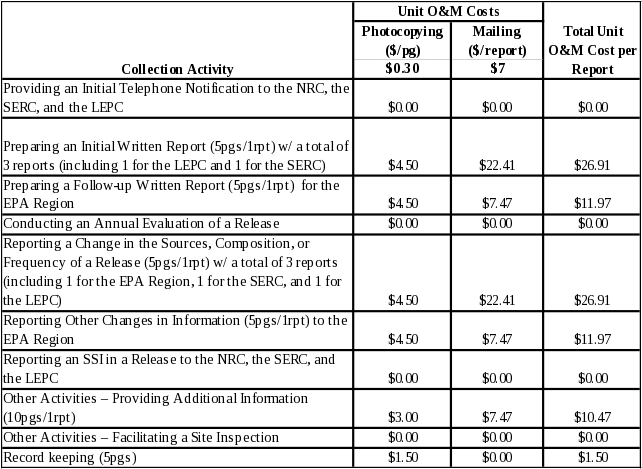
Exhibit 5 (With Forms) shows the O&M costs that are incurred by industries that are using the continuous release reporting forms. We are not making changes to the assumption that each written report, the initial written report, and other changes in information report will require five pages; however, this assumption will be reviewed during the next renewal. There is no difference realized in O&M unit costs when the continuous release reporting forms are used.
Exhibit 5 (With Forms) – Unit Operating and Maintenance Costs per Respondent Information Collection Activity
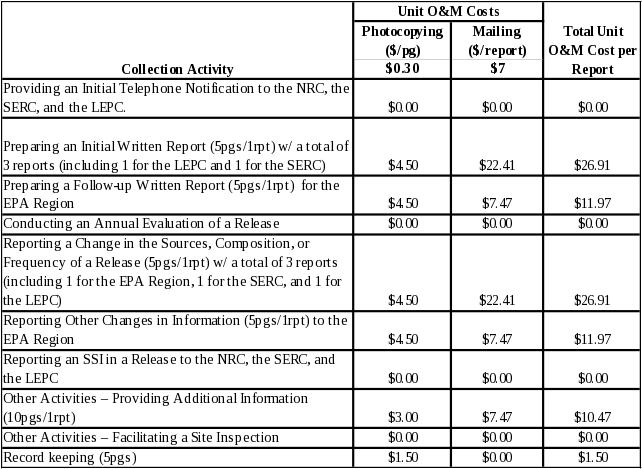
In Exhibit 6, O&M costs for a typical facility are presented.
Exhibit 6 – Operating and Maintenance Costs for a Typical Facility
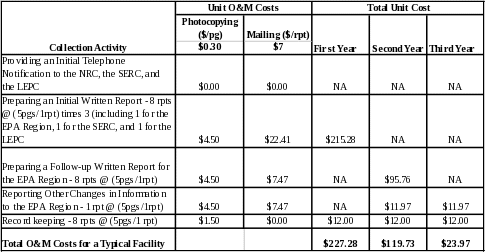
A “typical” respondent is assumed to report eight continuous hazardous substance releases in year one and to experience a change in one release in the second and third years (e.g., the frequency of the release per week changes each year, causing a modification in the estimated annual release amount). No other conditional activities are assumed to be required of the typical respondent. |
NA = Not Applicable
In Exhibit 6 (With Forms), O&M costs for a typical facility that will use continuous release reporting forms are presented. There is no difference in O&M unit costs for a typical facility.
Exhibit 6 (With Forms) – Operating and Maintenance Costs for a Typical Facility
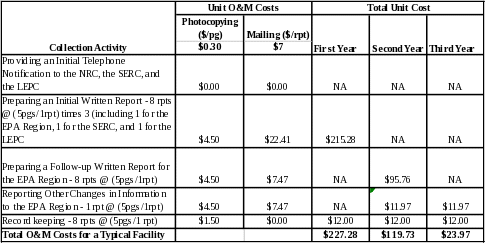
A “typical” respondent is assumed to report eight continuous hazardous substance releases in year one and to experience a change in one release in the second and third years (e.g., the frequency of the release per week changes each year, causing a modification in the estimated annual release amount). No other conditional activities are assumed to be required of the typical respondent. |
Annual labor and O&M costs incurred by the regulated community are summarized in Exhibit 7.
Exhibit 7 – Unit Labor and Operating and Maintenance Costs per Respondent Information Collection Activity

Annual labor and O&M costs incurred by the regulated community that will use continuous release reporting forms are summarized in Exhibit 7 (With Forms).
Exhibit 7 (With Forms) – Unit Labor and Operating and Maintenance Costs per Respondent Information Collection Activity
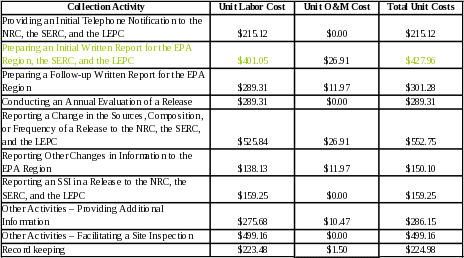
In Exhibit 86, annual labor and O&M costs for a typical facility are presented.
Exhibit 8 – Labor and Operating and Maintenance Costs for a Typical Facility

A “typical” respondent is assumed to report eight continuous hazardous substance releases in year one and to experience a change in one release in the second and third years (e.g., the frequency of the release per week changes each year, causing a modification in the estimated annual release amount). No other conditional activities are assumed to be required of the typical respondent. |
NA = Not Applicable
In Exhibit 8 (With Forms)7, annual labor and O&M costs for a typical facility are presented.
Exhibit 8 (With Forms) – Labor and Operating and Maintenance Costs for a Typical Facility
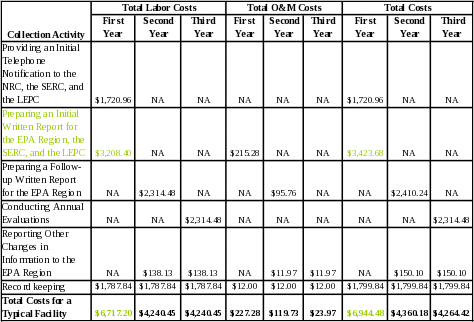
A “typical” respondent is assumed to report eight continuous hazardous substance releases in year one and to experience a change in one release in the second and third years (e.g., the frequency of the release per week changes each year, causing a modification in the estimated annual release amount). No other conditional activities are assumed to be required of the typical respondent. |
N/A = Not Applicable
To comply with the provisions of the CRRR, Federal government (NRC and EPA Region) and SERC and LEPC authorities perform the following activities (see also Section 5(a) of this ICR): (1) process initial telephone notification (NRC, SERC, and LEPC); (2) process initial written report (EPA Region, SERC, and LEPC); (3) process follow-up written report (EPA Region only); (4) process change in the sources, composition or frequency of release reports (EPA Region, SERC, and LEPC); (5) process other changes in information; (6) process SSI reports (NRC, SERC, and LEPC); and (7) conduct other necessary activities (obtain additional information, conduct site inspection) (EPA Region). The estimated burden to the Federal government, the SERC and the LEPC
Exhibit 9 presents the estimated burden-hours and unit cost associated for each of the activities described above for the Federal government (NRC and EPA Region), SERC and LEPC, which includes processing and evaluation of the various continuous release reports, as well as the burden and cost associated with any other government initiated activities that may involve the collection of information. The unit cost estimates presented in Exhibit 9 are derived by multiplying the applicable burden estimates by the average hourly wage rate for government employees. Based on the 2018 GS pay schedule, EPA estimates an average hourly labor cost of $48.75 for the average Federal government employee.8 A full description of the basis for each government burden estimate is provided in the remainder of this section. In addition, according to the BLS, the average hourly labor cost for SERCs and LEPCs is $50.26. 9
Exhibit 9 – Unit Burden Hours and Costs Incurred by the Government per Information Collection Activity
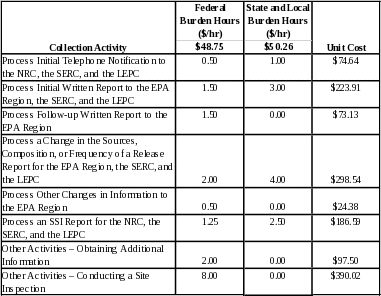
We believe that submission of continuous release reporting forms will increase efficiencies in processing reports by the Federal government as well as SERCs and LEPCs. For the purposes of this analysis, we are assuming that processing forms will save approximately 1/3rd of estimated average times for each activity that requires processing a report. This assumption will be reviewed during the next renewal. Exhibit 9 (With Forms) presents the estimated burden-hours and unit cost associated with the Federal government’s, SERCs, and LEPCs processing and evaluation of the various continuous release reports, as well as the burden and cost associated with any other government initiated activities that may involve the collection of information when continuous release reporting forms are submitted by industries.
Exhibit 9 (With Forms) – Unit Burden Hours and Costs Incurred by the Government per Information Collection Activity

Process Initial Telephone Notification – EPA estimates that the NRC, the SERC, and the LEPC requires 30 minutes (0.5 hours each) to process the information provided in the initial telephone call. The first-year unit cost associated with processing the initial telephone call is $74.64.
We do not expect that the use of the continuous release reporting forms will reduce the burden associated with processing the initial telephone call.
Process Initial Written Report – Government authorities (EPA Region, SERC, LEPC) review initial written reports to become familiar with the nature and extent of the release, to determine if the release qualifies for reduced reporting under CERCLA section 103(f)(2) and to assess the hazards to public health and welfare and the environment. EPA estimates that the preliminary evaluation of the release requires on average, 4.5 hours (1.5 hours for each entity) of government time (federal, state, and local). The costs of processing and evaluating the initial written report are incurred in the first year of reporting. Therefore, the unit cost for processing and evaluating the initial written report is $223.91.
We estimate that the preliminary evaluation of the release will require on average, 3 total hours (one hour per entity) of government time (federal, state, and local) to process continuous release forms. Thus, the unit cost for processing and evaluating the initial written report forms is $149.27.
Process Follow-up Written Report (“First Anniversary Report”) -- Within one year of submitting the initial written report, facilities must submit a written follow-up report to update and confirm previously submitted information. The follow-up report provides EPA with a more accurate baseline against which to evaluate both the threat posed by the release and the impact that SSIs in the release may have on public health and welfare and the environment. The activities necessary to reevaluate the continuous release with the newly submitted follow-up report are assumed to be identical to those required to process and evaluate the initial written report, 1.5 hours, but are incurred by the EPA Region only. The costs associated with the follow-up written report are incurred in the second year of reporting. Therefore, the unit cost for processing and evaluating the follow-up written report is $73.13.
We estimate that the activities necessary to reevaluate the continuous release with the newly submitted follow-up report of the release will require on average, one hour of government time at the EPA Region to process continuous release forms. Thus, the unit cost for processing and evaluating the follow-up written report forms is $48.75.
Process a Change in the Sources, Composition, or Frequency of a Release Report – After initial notification reports have been submitted for a release and reporting under CERCLA section 103(f)(2) has commenced, EPA Region, SERC, and the LEPC must be notified of any changes in release information previously submitted. Any change in the sources, composition, or frequency of a hazardous substance release constitutes a new release. Thus, any facility experiencing a change in the sources, composition, or frequency of a continuous release must complete the initial notification process for the new release. Government activities (federal, state, and local) associated with new release reports consist of the processing and evaluation of the initial telephone and initial written reports, 6 hours. The applicable unit cost is $298.54 per new continuous release report.
We estimate that the government (federal, state, and local) activities associated with new release reports to process a change in the sources, composition, or frequency of a release report will be reduced to 4.5 hours. The applicable unit cost is $223.91 per new continuous release report using the continuous release reporting forms.
Process Other Changes in Information – For changes in a release other than a change in the sources, composition, or frequency, the person in charge must notify the EPA Region by submitting a letter presenting the updated information and explaining the reasons for the change. EPA estimates that processing a letter of changed information requires approximately 30 minutes (i.e., 0.50 hours) of Federal government time. This estimate consists of the time necessary to evaluate the release in light of the changed information. The shorter evaluation time is assumed because it is necessary to evaluate only the incremental change in the risk using previous assessments of the release (assumed to be on file) as a baseline. The applicable unit cost is $24.38 per changes in a release report.
We estimate that the Federal government activities associated with processing other changes in information will be reduced to fifteen minutes (0.25 hours). The applicable unit cost is $12.19 per report of changed information.
Process an SSI (Statistically Significant Increase) Report – SSIs are episodic releases and must be reported immediately to the NRC, the SERC, and the LEPC. Release quantities in excess of the normal range have not been previously reported and evaluated and, thus, warrant immediate reporting. Upon receiving notification of an SSI, the NRC will record the SSI information in the NRC data base (15 minutes) and notify the appropriate EPA Region of the SSI report (15 minutes). Upon notification from the NRC (15 minutes), EPA will evaluate the potential hazard posed by the release in light of the SSI (30 minutes). The SERCs and the LEPCs are also taking 1.25 hours each to process this information. Thus, the Federal, state, and local governments are estimated to require three hours and forty-five minutes (3.75 hours) of government time to process and evaluate each SSI reported under the CRRR. The applicable cost is $186.59 per SSI Report.
We estimate that EPA’s, the SERCs, and the LEPC’s activities associated with processing an SSI report will be reduced by fifteen minutes each. This will reduce the overall government’s (Federal, state, and local) time to process and evaluate each SSI reported under the CRRR to three hours. The applicable unit cost is $149.27 per SSI Report.
Other Activities – For some percentage of continuous releases, the information provided in the initial and/or follow-up reports will be incomplete, incorrect, or worrisome, prompting EPA to request additional information concerning the release and its associated hazard. For example, additional information may be necessary to confirm the continuity and stability of the release or to better assess the risk posed by the release. EPA estimates that the process of requesting and reviewing additional information concerning a continuous release requires 2.0 hours of Federal government time. The applicable unit cost is $97.50 per request and review of additional information. (Note: We assume that state and local agencies may accompany EPA Region for inspections. Therefore, we did not account any additional burden for state and local agencies for requiring any additional information or site inspection).
We estimate that the government activities associated with reviewing additional information concerning a continuous release will be reduced to one and one-half hours of Federal government time. The applicable unit cost is $73.13 per request and review of additional information.
In extreme cases, the preliminary risk assessment of a release will suggest the need for a site inspection, allowing EPA to directly assess and evaluate the circumstances of a release and the population and environment potentially affected by the release. In addition, site inspections are conducted periodically as a compliance and enforcement measure. EPA estimates that site inspections will require 8.0 hours of government time, including one hour allocated for the EPA Region to communicate its concerns and findings to the appropriate SERC and LEPC, and will cost $390.02. (Note: We assume that state and local agencies may accompany EPA Region for inspections. Therefore, we did not account any additional burden for state and local agencies for this activity).
We do not believe that submission of continuous release reporting forms will change the estimate for government time for site inspections.
The estimates presented in this ICR regarding the number of facilities and hazardous substance releases affected by the CRRR were computed using the number of CR-ERNS notifications made by the NRC to each respective region over the years 2015, 2016, and 2017 as reported by the NRC. It should be noted that in 2017, the actual number of calls to the NRC for continuous release reports went up due to the fact that in December 18, 2008, EPA published a final rule that exempted most farms from certain release reporting requirements in CERCLA and EPCRA. Specifically, the rule exempted farms releasing hazardous substances from animal waste to the air above threshold levels from reporting under CERCLA. For EPCRA reporting, the rule exempted reporting of such releases if the farm had fewer animals than a large concentrated animal feeding operation (CAFO). In short, all farms were relieved from reporting hazardous substance air releases from animal waste under CERCLA, and only large CAFOs were subject to EPCRA reporting. Several citizen groups challenged the validity of the final rule in the U.S. Court of Appeals for the District of Columbia Circuit. On April 11, 2017, the Court struck down the final rule, eliminating the regulatory reporting exemptions for farms. The Court issued its mandate on May 1, 2018 . However, due to legislative changes in the “Fair Agricultural Reporting Method Act” or “FARM Act” in March 2018, “air emissions from animal waste at a farm” are exempt from reporting under CERCLA. These types of releases also do not need to be reported under EPCRA. Prior to the legislative changes and court mandate, NRC received initial notifications from many farms after the April 11, 2017, court vacatur, which raised the number of reports that NRC received in 2017.
The number of reports to be filed in the next three years is computed from the total number of reports already filed and reflects the number of annual reports in recent years, excluding the calls from 2017 related to releases from farms mentioned above. EPA has estimated that each affected facility has 8 continuous releases above the releases’ RQs. Exhibit 10 summarizes the estimated number of facilities and hazardous substance releases already affected by the CRRR. The change report adjustment reflects 10% of the total number of facilities and reports for all regions. The same number of facilities is assumed for use of continuous release reporting forms.
Exhibit 10 – Number of Facilities and Hazardous Substance Releases Already Affected by the CRRR

Exhibit 11 presents the estimate for the number of facilities and hazardous substance releases that will be affected by the CRRR in the next three years. The estimate is based on an expected 7.5% average annual percent increase in facilities (see 6(f)) adjusted from the number of continuous release notifications reported by the NRC for 2015. The same estimate is assumed for the use of continuous release reporting forms.
Exhibit 11 – Number of Facilities and Hazardous Substance Releases That Will Be Affected by the CRRR in the Next Three Years

The total estimated and annual burden hours and costs incurred by industry affected by the CRRR are presented in Exhibit 12. The total and annual hours and costs incurred by industry are calculated over a three year period.
Exhibit 12 – Annual
Burden Hours and Costs Incurred by Industry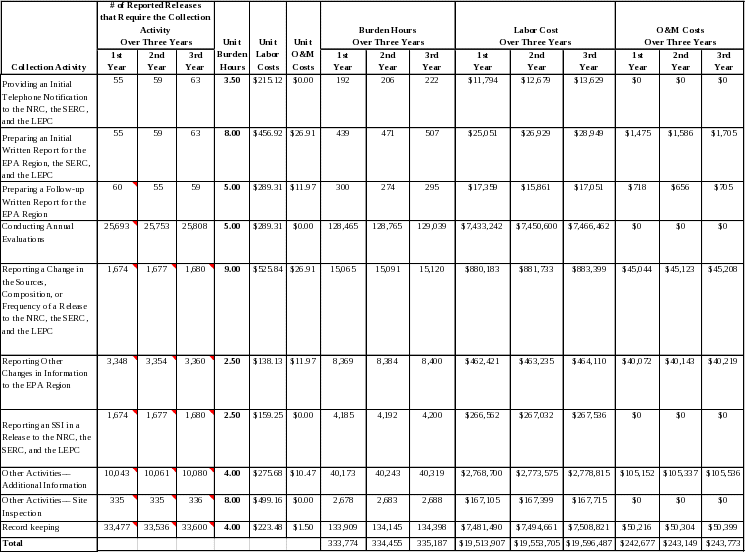
Exhibit 12 (With Forms) – Annual Burden Hours and Costs Incurred by Industry
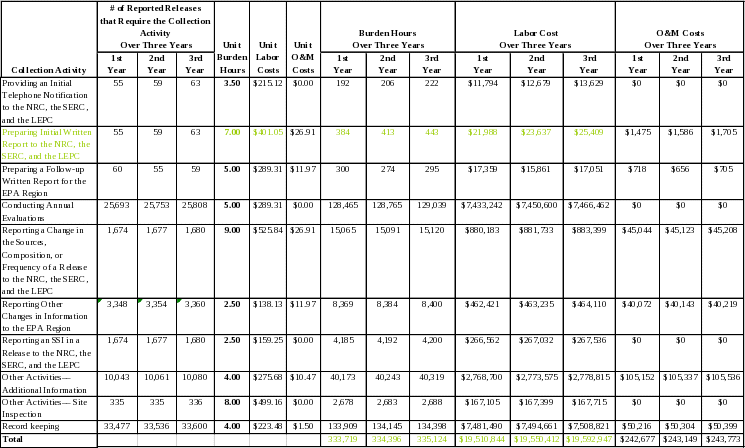
Exhibit 13 presents the total and annual estimated burden hours and costs incurred by government authorities as a result of the CRRR over a three year period.
Exhibit 13 – Annual Burden Hours and Costs Incurred by Government
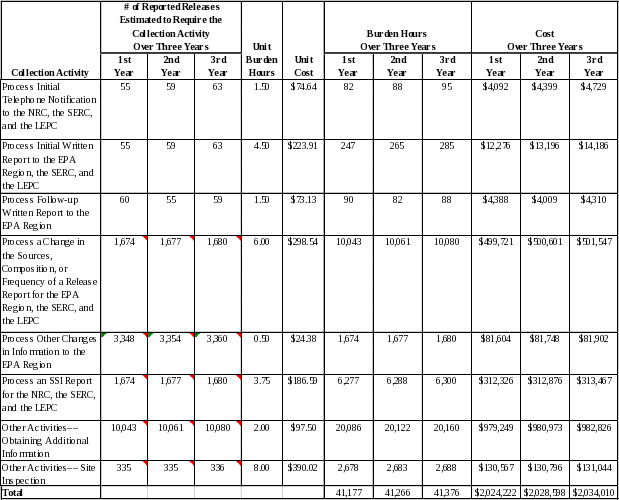
Exhibit 13 (With Forms) – Annual Burden Hours and Costs Incurred by Government
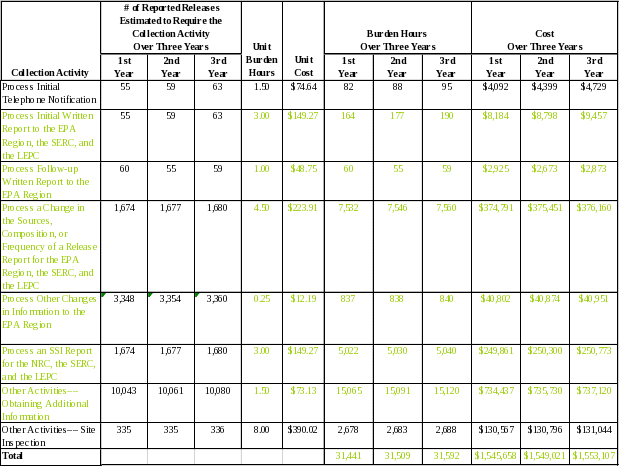
Exhibit 14 summarizes the estimated burden hours and costs incurred by industry. The bottom line burden to industry is approximately 333,774 hours for the first year and 334,455, and 335,187 hours for the second and third years, respectively. The bottom line industry labor costs are approximately $19,513,907 $19,553,705, and $19,596,487 for the first, second, and third years, respectively. The bottom line industry O&M costs are approximately$242,677, $243,149, and $243,773 for the first, second, and third years, respectively. The average burden for industry over a three-year period is 334,472 hours at an average labor cost of $19,554,699 and O&M cost of $243,200.
Exhibit 14 – Summary of Burden Hours and Costs Incurred by Industry
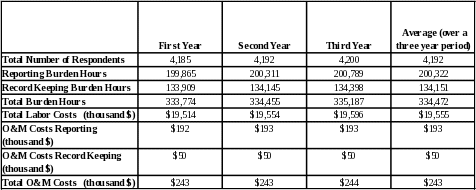
Exhibit 14 (With Forms) summarizes the estimate burden hours and costs incurred by industry. The revised bottom line burden to industry is approximately 333,719 hours for the first year and 334,396 and 335,124 hours for the second and third years, respectively. The revised bottom line industry labor costs are approximately $19,510,844, $19,550,412, and $19,592,947 for the first, second, and third years, respectively. The bottom line industry O&M costs remain the same. The revised average burden hours for industry over a three-year period is 334,413, a revised average labor cost of $19,551,401. The O&M average cost of $243,200 remains unchanged.
Exhibit 14 (With Forms) – Summary of Burden Hours and Costs Incurred by Industry

Exhibit 15 summarizes the estimated burden hours and costs incurred by Federal, state, and local government. The bottom line burden to the government is approximately 41,177, hours for the first year, 41,266 for the second, and 41,376 for the third year. The bottom line cost to the government is approximately $2,024,222, $2,028,598, and $2,034,010, respectively. The average burden hour for the government over a three-year period is 41,273 hours, at an average annual cost of $2,028,943.
Exhibit 15 – Summary of Burden Hours and Costs Incurred by Government

Exhibit 15 (With Forms) summarizes the estimated burden hours and costs incurred by government. The revised bottom line burden to the government is approximately 31,441 hours for the first year, 31,509 for second, and 31,592 for the third year. The revised bottom line cost to the government is approximately $1,545,658, $1,549,021, and $1,553,107, respectively. The revised average burden hour for the government over a three-year period is 31,514 hours, at an average annual cost of $1,549,262.
Exhibit 15 (With Forms) – Summary of Burden Hours and Costs Incurred by Government

This ICR increases the burden incurred by industry, as a result of compliance with the CRRR, from 315,966 to 334,472 estimated average burden hours. This increase in burden results primarily from use of data on the actual number of continuous release reports from several regions and applying a growth rate consistent with prior years reporting. The average annual percent increase in facilities in the previous ICR was approximately 7.5%. The same percent increase was assumed for this ICR. The unit burden hours per respondent information collection activity (Exhibit 1) remains the same as the previous ICR. In addition, it takes into account reporting to the SERCs and LEPCs required by EPCRA section 304.
We estimate that the use of the continuous release reporting forms will reduce the estimated average burden hours for industry from 334,472 to 334,413, an overall estimated savings of 59 hours.
The reporting and record keeping burden for this collection of information is estimated to average approximately 809 hours per affected facility (334,472 total burden hours/4,192 affected facilities), or 10.110 hours per response (where we estimate 8 responses/facility - see note to Exhibit 6), including determining if the hazardous substance release qualifies for reporting under the CRRR, gathering and maintaining the required information, and completing and reviewing the written reports. Burden means the total time, effort, or financial resources expended by persons to generate, maintain, retain, or disclose or provide information to or for a Federal agency. This includes the time needed to review instructions; develop, acquire, install, and utilize technology and systems for the purposes of collecting, validating, and verifying information, processing and maintaining information, and disclosing and providing information; adjust the existing ways to comply with any previously applicable instructions and requirements; train personnel to be able to respond to a collection of information; search data sources; complete and review the collection of information; and transmit or otherwise disclose the information. An agency may not conduct or sponsor, and a person is not required to respond to, a collection of information unless it displays a currently valid OMB control number. The OMB control numbers for EPA’s regulations are listed in 40 CFR part 9 and 48 CFR chapter 15.
We estimate that the revised reporting and record keeping burden for this collection of information is estimated to average approximately 8011per affected facility (334,413 revised total burden hours/4,192 affected facilities), or 10.112 hours per response (where we estimate 8 response/facility – see note to Exhibit 6), including determining if the hazardous substance release qualifies for reporting under the CRRR, gathering and maintaining the required information, and completing and reviewing the written reports.
To comment on the Agency’s need for this information, the accuracy of the provided burden estimates, and any suggested methods for minimizing respondent burden, including the use of automated collection techniques, EPA has established a public docket for this ICR under Docket ID No. EPA-HQ-SFUND-2015-0100, which is available for online viewing at www.regulations.gov, or in person viewing at the Superfund (SFUND) docket in the EPA Docket Center (EPA/DC), EPA West, Room 3334, 1301 Constitution Avenue, NW, Washington, D.C. The EPA Docket Center Public Reading Room is open from 8:30 a.m. to 4:30 p.m., Monday through Friday, excluding legal holidays. The telephone number for the Reading Room is (202) 566-1744, and the telephone number for the superfund docket is (202) 566-0276. An electronic version of the public docket is available at www.regulations.gov. This site can be used to submit or view public comments, access the index listing of the contents of the public docket, and to access those documents in the public docket that are available electronically. When in the system, select “search,” then key in the Docket ID Number identified above. Also, you can send comments to the Office of Information and Regulatory Affairs, Office of Management and Budget, 725 17th Street, NW, Washington, D.C. 20503, Attention: Desk Officer for EPA. Please include the EPA Docket ID Number EPA-HQ-SFUND-2015-0100 and OMB Control Number 2050-0086 in any correspondence.
APPENDIX A -- Phone-Log Summaries
The following calls were made on August 9 and August 10, 2018. The seven companies were selected from the universe of facilities for which a continuous release notification was made to the National Response Center in 2017. Persons responsible for making notifications were queried about the internal processes and procedures in place to make and follow-up on a Continuous Release Report and on the estimated number of hours they spent on performing the activities described in the ICR. These estimates were mostly lower than the estimates EPA has used in its burden estimates. However, EPA is erring on the conservative side, and will continue to use its higher estimates when calculating the cost and burden estimates for the ICR.


BP Cherry Point Refinery
Private Enterprise
Blaine, WA
Incident Report #1174525
On March 31, 2017, BP Cherry Point Refinery called the NRC to report an annual update to its continuous release of combustion NOX into the atmosphere from a refinery due to normal operations. On August 9, 2018, the HQ EPA analyst spoke with the person responsible for reporting releases. The company representative indicated that they have internal procedures in place for determining and reporting a continuous release. They are aware and have submitted copies of the continuous release reports to the appropriate SERCs and LEPCs, and they do not have any questions regarding reporting continuous releases.
The company representative estimated that facility staff spent a total of approximately 40 to 50 hours over a two-week period on all the activities required under the Continuous Release Reporting requirements for its March 31, 2017 report. This estimate falls within the burden estimate EPA is using for the ICR.

Blue Ridge Paper Products
Private Enterprise
Canton, NC
Incident Report #1182623
On June 29, 2017, Blue Ridge Paper Products called the NRC to report an initial continuous release to the atmosphere of hydrogen sulfide (265.95 lbs/day), methyl mercaptan (146.06 lbs/day), nitrogen oxide (6,562.08 lbs/day) beginning on June 29, 2017, with no scheduled end date. The caller also reported updated changes in source composition of 12 other substances; eight of those changes were to reduce the continuous release to below the RQ for that substance.
On August 9, 2018, the HQ EPA analyst spoke with the person responsible for reporting releases. The company representative indicated that the facility hired a consultant to model air releases of the substances, provide a script to the company representative for the notification call to the NRC, prepare the 30-day report and the follow-up one-year report. Some of the consultant’s time on this effort was also used by the facility to comply with other reporting requirements.
With assistance from the consultant, the facility now has internal procedures in place for determining and reporting a continuous release. They are aware of, and have submitted copies of the continuous release reports to the appropriate SERCs and LEPCs, and they do not have any questions regarding reporting continuous releases.
The representative estimated that he spent a total of 12 hours on the Continuous Release reporting activities. This estimate falls well within the burden estimate EPA is using for the ICR.

International Paper
Private Enterprise
New Bern, NC
Incident Report #1185793
On July 31, 2017, International Paper called the NRC to make a report of change in source or composition of a continuous release from a boiler to the atmosphere.
On August 9, 2018, the HQ EPA analyst spoke with the person responsible for reporting releases. The company representative indicated that the release was a venting of gases from a collection system directed to the boiler. At the time of the continuous release, the facility had been owned by International Paper for only a few months. The release was just at the limit of the RQ.
The facility does have procedures in place for continuous release reporting. They are aware and have submitted copies of the continuous release reports to the appropriate SERCs and LEPCs, and they do not have any questions regarding reporting continuous releases, although at the time of the release, the representative was not sure whom to call in addition to the LEPC.
The company representative estimated that facility staff spent a total of approximately 12 hours on all the activities required under the Continuous Release Reporting requirements for its July 31, 2017 report. This estimate falls well within the burden estimate EPA is using for the ICR.

Domtar Paper Company
Private Enterprise
Hawesville, KY
Incident Report #1186622
On August 8, 2017, Domtar Paper Company called the NRC to make a report of a statistically significant increase of acrolein into the air as part of their normal operating procedures.
On August 9, 2018, the HQ EPA analyst spoke with the person responsible for reporting releases. The company representative indicated that the release occurred as described in the NRC report. He also stated that he was aware of the reporting requirements for the release, and found the information on the CERCLA reporting sheets to be very helpful.
The company representative estimated that facility staff spent a total of approximately 10 hours on all the activities required under the Continuous Release Reporting requirements for its August 8, 2017 report. This estimate falls well within the burden estimate EPA is using for the ICR.

Tennessee Valley Authority
Federal Government
Chattanooga, TN
Incident Report #1189730
On September 8, 2017, the Tennessee Valley Authority called the NRC to make a report of an initial continuous release of ammonia from the air pollution control device during a process to control the nitrous oxide during normal operating procedures. The nitrous oxide is created from the combustion of natural gas or fuel oil. The caller reported the continuous release of ammonia and acrolein into the atmosphere. The acrolein is a result of the combustion.
On August 9, 2018, the HQ EPA analyst spoke with the person responsible for reporting releases. The company representative indicated that the continuous release from a combined cycle natural gas plant was as described in the NRC report. He also stated that he was aware of the reporting requirements for the release.
The company representative estimated that facility staff at the TVA’s Mussel Shoals plant spent a total of approximately 10 hours on all the activities required under the Continuous Release Reporting requirements for its Sept. 8, 2017 report. This estimate falls well within the burden estimate EPA is using for the ICR.
Montana Dakota Utilities
Public Utility
Bismarck, ND
Incident Report #1197866
On November 21, 2017, Montana Dakota Utilities called the NRC to make a report of an initial continuous release of acrolein from a combustion turbine.
On August 10, 2018, the HQ EPA analyst spoke with the person responsible for reporting releases. The company representative indicated that this continuous release report was the representative’s second report, so he was able to use a previously prepared report and other documents, as the basis for this report. The representative had anticipated that the turbine would run and make the release. He also stated that initially, he was not certain about the notification responsibilities, but once he created a spreadsheet to track the first continuous release, he was able to use it for this incident, which saved him a lot of time. The NRC staff person he contacted about this release told him that the NRC would contact the LEPC to notify it of the release, but the company representative would send in the form to the LEPC. At the one-year anniversary of the release, which will occur in November 2018, he expects it will be easier to submit one-year report because the facility now has procedures in place and template document ready to be updated.
The company representative estimated that facility staff spent a total of approximately 25 hours on all the activities required under the Continuous Release Reporting requirements for its Nov. 21, 2017 report. This estimate falls well within the burden estimate EPA is using for the ICR.
1 2050-0086 (EPA No. 1445.12) expires on November 30, 2018. EPA revised the CRR form and instructions and we will replace the existing version on our website after OMB approval. Facilities may continue to use the form that is currently available on our website at https://www.epa.gov/epcra/appendix-b-reporting-requirements-continuous-releases-hazardous-substances.
2That data base is available at: http://www.nrc.uscg.mil/
3The burden reduction is estimated to be one hour/initial notification activity and information collection activity which is why these numbers are the same as the paragraph above.
4 Bureau of Labor Statistics’ news release dated, March 20, 2018, entitled, “Employer Costs for Employee Compensation - December 2017 listed hourly compensation (wages and salaries plus fringe benefits) rates for civilian managerial, technical, and clerical workers. Therefore, the wage rates used in this ICR (1445.13) include salaries, fringe benefits, overhead costs and general and administrative costs as of December 2017.
5 Postage includes $0.92 (3oz), certified $3.45, and return receipt $2.75. Certified and return receipt are not required, however, we expect most respondents to incur these costs.
6 Exhibit 8 does not include capital costs because there is no capital costs associated with implementing the regulations of the CRRR.
7 Exhibit 8 (With Forms) does not include capital costs because there is no capital costs associated with implementing the regulations of the CRRR.
8 This hourly wage estimate was calculated by summing the basic hourly wage rate for a GS-12 step 1 government employee in 2018 ($30.47) and the hourly monetary value of the representative employee’s fringe benefits (assumed to be the basic hourly wage rate multiplied by 60 percent).
9 Bureau of Labor Statistics’ news release dated, March 20, 2018, entitled, “Employer Costs for Employee Compensation - December 2017 listed hourly compensation (wages and salaries plus fringe benefits) rates for state and local government managerial, technical, and clerical workers. Therefore, the wage rates used in this ICR (1445.13) include salaries, fringe benefits, overhead costs and general and administrative costs as of December 2017.
980 hrs/facility is further broken out to 48 hours for reporting (200,322 reporting burden hours/4,192 affected facilities) and 32 hours for record keeping (134,151 record keeping hours/4,192 affected facilities)
10 6.0 hours for reporting and 4.0 for record keeping.
11 80 hrs/facility is further broken out to 48 hours for reporting (200,263 reporting burden hours/4,192 affected facilities) and 32 hours for record keeping (134,151 record keeping hours/4,192 affected facilities).
12 6.0 hours for reporting and 4.0 for record keeping.

OMB Version
September 2018
Page
| File Type | application/vnd.openxmlformats-officedocument.wordprocessingml.document |
| File Title | RENEWAL OF INFORMATION COLLECTION REQUEST FOR THE CONTINUOUS RELEASE REPORTING REQUIREMENT |
| Author | MDSADM10 |
| File Modified | 0000-00-00 |
| File Created | 2021-01-20 |
© 2025 OMB.report | Privacy Policy